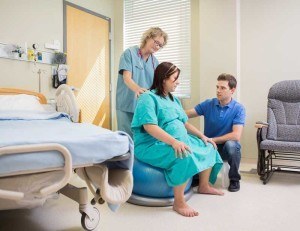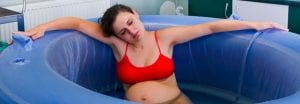
Around the world the majority of children are born via natural delivery, in other words vaginally. Most people assume that the best option for delivery is the traditional way of lying in bed. However, delivering while lying down is not optimal for all women.
Birth While Lying Down: The Natural Delivery Bed
 Most women today still prefer the delivery bed for giving birth. This is the most practical method for doctors and midwives, as it allows them to follow the birthing process easily, and enables them to intervene if necessary. The advantage for the mother is knowing what to expect and being in a comfortable bed that allows rest in between contractions. Another advantage is the ability to quickly change your birthing position without the need for changing beds in case of a complication. The midwife is also able to have better control over perineum protection due to the height of the bed. This birthing position is also ideal for pregnant ladies who wish to have access to an epidural. Delivering while lying down also has several disadvantages: For
Most women today still prefer the delivery bed for giving birth. This is the most practical method for doctors and midwives, as it allows them to follow the birthing process easily, and enables them to intervene if necessary. The advantage for the mother is knowing what to expect and being in a comfortable bed that allows rest in between contractions. Another advantage is the ability to quickly change your birthing position without the need for changing beds in case of a complication. The midwife is also able to have better control over perineum protection due to the height of the bed. This birthing position is also ideal for pregnant ladies who wish to have access to an epidural. Delivering while lying down also has several disadvantages: For
Delivering while lying down also has several disadvantages: For example, it is possible that the cervix is slower to open in a laying position, which hinders gravity from helping the baby exit. This lengthens the time of delivery in most cases. Pain is also often amplified, as the pressure on ligaments, the vagina, muscles, and the abdomen are less even than when standing, for example. Permanently lying can even become dangerous, as it can cause Inferior Vena Cava Syndrome as the weight of the child can hinder blood flow to the heart. This can cause nausea and circulatory disturbances for the mother which in turn threatens the oxygen supply of the child. Modern hospitals have electric delivery beds that are split up into three moveable parts so that the bed can even be changed into the shape of a birthing chair.
Upright Delivery
Delivering in an upright position is now viewed as a great alternative to the classic delivery method of lying down, as it offers many advantages. Upright (vertical) delivery methods include kneeling, squatting, standing and sitting. An advantage of birth in an upright position is the capability of the mother to experiment and figure out which position is the most comfortable and allows her to be active in her birth experience. Another benefit is that being in an upright position allows gravity to play a role in speeding up delivery. If the mother delivers in an upright position, then both labor and expulsion can be performed more quickly than when in a lying position. Another advantage is that the pelvic opening broadens in this position. Contractions are also less painful and episiotomies are less common. Additionally, an upright position allows for better blood circulation, which in turn gives the child the optimal amount of oxygen. A number of aids are available for those wanting to deliver in an upright position:
Birthing Stools and Birthing Chairs
For this birth method, the mother sits on a half circle shaped stool with four legs and no backrest that has an opening allowing the baby to come out. The advantage is that the mother delivers in an upright position, which exudes more pressure during contractions and allows the mother to push the child out of the birth canal more quickly. The feet of the mother are planted firmly on the ground, which stabilizes her back and allows for heightened mobility of the pelvis. Due to the upright position, pelvic floor injuries are less common, and the child exits more quickly during the final contractions. Another benefit is that the partner can support the mother from behind. A disadvantage is that birthing stools are uncomfortable. Due to not being very high, doctors and midwives must be squatting, which makes it more difficult to follow the delivery process. The baby also exudes greater pressure with its head, which can make it uncomfortable for many mothers. An alternative to a birthing stool is a birthing chair, which is an adjustable recliner that resembles the exam chair at a gynecologist’s office. The advantage is that the mother can decide whether she wants to be upright or lying down, and it is also not as low to the floor as a birthing stool. The disadvantage is that the chair is not very comfortable. Women who suffer from varicose veins in the genital region cannot use the birthing stool, as the upright position can cause swelling in the vaginal opening which could hinder the baby from fitting through the opening.
Wall Bars
Most of us are familiar with wall bars from gym class. However, this piece of equipment can also be advantageous when used during delivery. The benefit of wall bars is that it allows for an upright position which shortens the opening phase and allows gravity to help out. It also takes the strain off the back. The mother can either sit or squat while holding onto the wall bars. To increase comfort, the height of the bars can be adjusted. A birthing rope or holding towel can be fastened to the wall bars which can be used by the mother to support herself. The disadvantage is that prolonged standing during labor can be very strenuous.
Birthing Ball (Exercise Ball)
 Another method that helps advance delivery is the use of a birthing ball. It is a large exercise ball on which the mother can sit with spread legs. The ball can also be used from a kneeling position by resting hands or upper body on it. The advantage here is that the birth canal opens up through the sitting position and the head of the child can sit lower. Circular motions of the pelvis can help the child to make its exit easier. The partner can help the woman by supporting her from behind, lending her a hand or giving her a massage. The disadvantage is that the ball is not very stable, making it ill-suited for the actual delivery.
Another method that helps advance delivery is the use of a birthing ball. It is a large exercise ball on which the mother can sit with spread legs. The ball can also be used from a kneeling position by resting hands or upper body on it. The advantage here is that the birth canal opens up through the sitting position and the head of the child can sit lower. Circular motions of the pelvis can help the child to make its exit easier. The partner can help the woman by supporting her from behind, lending her a hand or giving her a massage. The disadvantage is that the ball is not very stable, making it ill-suited for the actual delivery.
Birth Wheel (Roma Wheel)
The birth wheel is yet another available birth method which likens a hammock. When using this device the mother is in an almost laying or sitting position. The advantage is that the upright position allows gravity to help in opening the cervix, and a hollow back during delivery is avoided. The birth wheel is nicely padded and enables the mother to decide for herself what position she would like to be in. The device also has special straps for the woman to brace herself with her feet. In between contractions, this special birthing chair can rock back and forth for relaxation. The only rare disadvantage is when someone is prone to seasickness, as the birthing wheel’s movement can feel like the movement of waves.
Birth on All Fours
In this position, the mother kneels on all fours, which is still a known position today among indigenous peoples. The advantage is that weight is distributed evenly between arms and legs. This position also allows for a high range of motion which can guard against bad positions such as a hollow back. This position is recommended with the presence of back pain, as the pressure on the tailbone and backbone is diminished. There is also less strain on the intestines, which can lead to less tearing. Kneeling on all fours can be done on top of the hospital bed as well as on another soft surface. This position also helps with babies that are in a breech position and lessens the chances of a cesarean section. The disadvantage is that this method can be very strenuous, especially for the arm and leg muscles. Many women also feel uncomfortable in this position as it is often related to sexuality.
Water Birth
 A more specialized kind of birth is a water birth, which can occur in two different ways: Either the mother will labor in the bathtub to lessen the pain of contractions and then give birth “on land,” or she will complete the delivery directly in the water. Most labor wards have birthing pools available that are larger than the average bathtub that allows for higher mobility for the mother. The water temperature is usually between 34 and 36 degrees Celsius. This birth method has several advantages. Many women find the warm water to be soothing and pain-relieving and positional changes are very easy in a birthing pool. The warm water can also help to dilate the cervix and strengthen contractions during labor. During the second stage of labor, the pelvis is stretched more easily and the pelvic muscles are loosened. Many women also find the pressure the child exudes on the pelvic floor to be less intense in the birthing pool. Studies show that pain medication is used much less frequently when a woman is in a birthing pool. Many mothers are fearful that their baby will breathe in water or drown in the birthing pool, but these worries are unfounded as children are born with a reflex that stops them from breathing under water. As soon as the baby surfaces it is removed from the pool and cared for. The placenta (afterbirth) can also be delivered in the birthing pool. Another advantage is that intestinal tears and cuts are less common with this birthing method. A disadvantage is the higher risk for infection, which is still rare due to the good hygiene standards in hospitals. Another negative aspect is that in the case of complication valuable time can be lost transferring the mother out of the pool. Pain medication such as epidurals can also not be used during a water birth. Under certain circumstances, a water birth has to be ruled out. This includes infections in the mother, birth of multiples, difficult presentation, as well as some illnesses and premature birth. Different kinds of birth can make delivery easier, but many pregnant women have fears ahead of time of a painful birth that hinders them from making a good decision. In these cases, hypnobirthing may help, which is a method that is used to prepare the mother for one of the most important events in her life without fear.
A more specialized kind of birth is a water birth, which can occur in two different ways: Either the mother will labor in the bathtub to lessen the pain of contractions and then give birth “on land,” or she will complete the delivery directly in the water. Most labor wards have birthing pools available that are larger than the average bathtub that allows for higher mobility for the mother. The water temperature is usually between 34 and 36 degrees Celsius. This birth method has several advantages. Many women find the warm water to be soothing and pain-relieving and positional changes are very easy in a birthing pool. The warm water can also help to dilate the cervix and strengthen contractions during labor. During the second stage of labor, the pelvis is stretched more easily and the pelvic muscles are loosened. Many women also find the pressure the child exudes on the pelvic floor to be less intense in the birthing pool. Studies show that pain medication is used much less frequently when a woman is in a birthing pool. Many mothers are fearful that their baby will breathe in water or drown in the birthing pool, but these worries are unfounded as children are born with a reflex that stops them from breathing under water. As soon as the baby surfaces it is removed from the pool and cared for. The placenta (afterbirth) can also be delivered in the birthing pool. Another advantage is that intestinal tears and cuts are less common with this birthing method. A disadvantage is the higher risk for infection, which is still rare due to the good hygiene standards in hospitals. Another negative aspect is that in the case of complication valuable time can be lost transferring the mother out of the pool. Pain medication such as epidurals can also not be used during a water birth. Under certain circumstances, a water birth has to be ruled out. This includes infections in the mother, birth of multiples, difficult presentation, as well as some illnesses and premature birth. Different kinds of birth can make delivery easier, but many pregnant women have fears ahead of time of a painful birth that hinders them from making a good decision. In these cases, hypnobirthing may help, which is a method that is used to prepare the mother for one of the most important events in her life without fear.
What is Hypnobirthing?
Hypnobirthing is meant to be a birth with minimal pain and without fear, using relaxation and hypnotic methods. But is this really possible? American Marie F. Mongan is viewed as the inventor of this method, which focuses on self-hypnosis and deep relaxation. Since 1989 hypnobirthing can be practiced in classes. The concept is that fear blocks the body and makes the muscles tense, even in a woman giving birth. In order to have a pain free birth relaxation is crucial. With the help of self-suggestion, the mother is encouraged to relax her body, which in turn releases fear and mental blocks. During hypnobirthing, the mother finds herself in a trance-like state while still being awake and aware of her surroundings. The advantage is that pain medication is no longer necessary for this method, contractions are perceived as waves, and the baby is breathed out downward. Hypnobirthing can be done at a hospital as well as at home or in a birth center. The method can be taught by midwives in prenatal classes and includes four basic techniques: breathing, visualizing, relaxing and deepening. Negative terms such as labor pains are only referred to as contractions, and fears that are present from previous births are released. During deep relaxation, the participants learn to breathe with their stomachs consciously and to progressively relax muscles, which includes the importance of massage from the partner. There is no guarantee that this method will lead to a pain-free birth, but a study conducted at the university in Tübingen and the Westfälische Institute for Hypnosis showed positive results. The delivery of firstborns using the method of hypnobirthing was shown to be on average two hours shorter, and only 50 percent of women using the method described horrible pain, while 80 percent of women not using the method said the same. Even in cases where pain occurs, hypnobirthing can help to better handle the pain. Many women who used this method for delivery were satisfied with the results, as they experienced a relaxing and deliberate delivery. Every birth is individual and unique, which is why not every method is suited for every woman. Expecting mothers should pay attention to their own needs and decide with input from their doctor and midwife what the advantages and disadvantages of each method are, in order to find the one that fits the best. After all, giving birth should be an incomparable experience.


